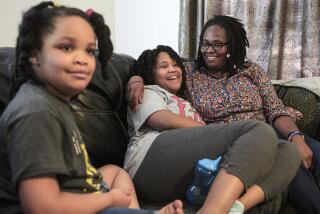Brain cancer overtakes leukemia as deadliest form of childhood cancer, CDC says
Treatments for kids with leukemia have improved so much that it is no longer the deadliest childhood cancer in the U.S., according to a new report from the Centers for Disease Control and Prevention.
The top spot now belongs to brain cancer, the CDC said.
Combined, the two diseases account for slightly more than half of all cancer deaths among Americans between the ages of 1 and 19 in 2014, the most recent year for which statistics are available.
Nearly 30% of the estimated 1,960 childhood cancer deaths that year were due to brain cancer, and 25% were the result of leukemia, according to the report published Friday by the CDC’s National Center for Health Statistics. An additional 10% were due to bone and articular cartilage cancers, 9% to thyroid and other endocrine gland cancers, and 8% to mesothelial and soft tissue cancers.
Combined, these five cancers accounted for more than four out of five cancer deaths among children and adolescents.
David F. Arons, chief executive of the National Brain Tumor Society, said the report underscores the need for new and better treatments for children who are diagnosed with brain cancer.
“Pediatric brain tumors have not become deadlier over the years – survival rates for these patients have stayed relatively flat for decades,” Arons said in a statement. “The reason these patients now face the highest mortality rates is because while other areas of oncology have made great strides in recent years, pediatric brain tumor research has not generated advances that have translated into meaningful clinical benefit for the most vulnerable patients.”
The good news is that the rate of childhood cancer deaths declined over the past 15 years, part of a trend that began in the mid-1970s. The 2014 death rate – 2.28 deaths per 100,000 kids and teens – was 20% lower than it was in 1999.
Boys were more vulnerable to cancer than girls, with death rates that were 10% to 30% higher throughout the 15-year period. In 2014, 2.57 out of every 100,000 boys and young men died of cancer, compared with 1.98 out of every 100,000 girls and young women, according to the report.
The cancer death rate was higher for older teens – 2.9 deaths per 100,000 adolescents between the ages of 15 and 19 – than for any other age group. The death rates for all other age groups ranged between 2.01 and 2.12 deaths per 100,000 kids, though those differences weren’t large enough to be statistically significant.
The cancer death rate declined for all age groups between 1999 and 2014, the report said.
It also fell for black and white children and teens. In 1999, 3.01 out of every 100,000 black kids and 2.85 of every 100,000 white kids died of some kind of cancer; in 2014, those figures were 2.32 and 2.36, respectively. The difference between the two racial groups was not statistically significant.
The report did not include rates for other racial or ethnic groups.
In the U.S., accidents and unintentional injuries are the leading cause of death for all kids and teens between the ages of 1 and 19, according to the National Center for Health Statistics. Cancer ranks second for children ages 5 to 9, third for kids ages 10 to 14, and fourth for all other youth age groups.
Follow me on Twitter @LATkarenkaplan and “like” Los Angeles Times Science & Health on Facebook.
MORE IN SCIENCE
Researchers strengthen link between Zika and microcephaly
6,000-year-old fabric reveals Peruvians were dyeing textiles with indigo long before Egyptians
10,000 instances of distracted driving a day are due to Pokemon Go
UPDATES:
12:45 p.m.: This story has been updated to include comments from David F. Arons, chief executive of the National Brain Tumor Society.
This story was originally published at 11:40 a.m.







